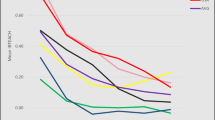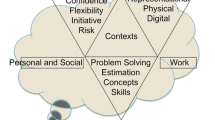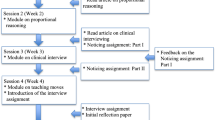Abstract
Being unaware of the assumptions underlying a deductive argument is widespread among learners and is a major stumbling block to their understanding of proof. Thus, the basic idea of the present paper is that at some points in the course of secondary education there should be classroom-based interventions addressing this difficulty and making the axiomatic organization of mathematics a theme. Students should be made aware that there are axioms in mathematics, what their role is and how mathematicians come to agree about which axioms should be accepted. An axiom which is not yet accepted is simply a hypothesis. A hypothesis is evaluated by deductively drawing consequences and by investigating whether these consequences agree with experience or should be accepted for other reasons. The teaching intervention discussed in this paper exemplifies this idea by way of the example of ancient attempts at modelling the path of the sun, the so-called “anomaly of the sun”. It is investigated to what extent the teaching intervention fostered students’ understanding of the conditionality of mathematical/astronomical statements, that is, of the fact that the truth of these statements is dependent on the initial hypotheses.










Similar content being viewed by others
References
Balacheff, N. (1991). The benefits and limits of social interaction: the case of mathematical proof. In A. J. Bishop, E. Mellin-Olsen, & J. V. Dormolen (Eds.), Mathematical knowledge: its growth through teaching (pp. 175–192). Dordrecht: Kluwer.
Balacheff, N. (2009). Bridging knowing and proving in mathematics: a didactical perspective. In G. Hanna, H. N. Jahnke, & H. Pulte (Eds.), Explanation and proof in mathematics. Philosophical and educational perspectives (pp. 115–135). New York: Springer.
Bartolini-Bussi, M. (2010). Experimental mathematics and the teaching and learning of proof. In V. Durand-Guerrier, S. Soury-Lavergne, & F. Arzarello (Eds.), Proceedings of the Sixth Congress of the European Society for Research in Mathematics Education 2009 (CERME 6, Lyon) (pp. 221–230). Paris: Institut Nationale de Recherche Pédagogique.
Bell, A. (1976). A study of pupils’ proof-explanations in mathematical situations. Educational Studies in Mathematics, 7, 23–40.
Boero, P., Garuti, R., & Lemut, E. (1999). About the generation of conditionality of statements and its links with proving. Proceedings of the XXIII International conference of PME, (vol. 2, pp. 137–144). Haifa: PME.
Boero, P., Garuti, R., & Lemut, E. (2007). Approaching theorems in grade VIII. In P. Boero (Ed.), Theorems in schools: from history, epistemology and cognition to classroom practice (pp. 249–264). Rotterdam: Sense Publishers.
Cabassut, R., Conner, A., Iscimen, A., Furinghetti, F., Jahnke, H. N., and Morselli, F. (2012). Conceptions of proof—in research and teaching. In G. Hanna, & M. de Villiers (Eds.), Proof and Proving in Mathematics Education. The 19th ICMI Study (pp. 169–190). Dordrecht: Springer.
Coe, R., & Ruthven, K. (1994). Proof practices and constructs of advanced mathematics students. British Educational Research Journal, 2(1), 41–53.
Freudenthal, H. (1973). Mathematics as an educational task. Dordrecht: Reidel.
Hadas, N., Hershkowitz, R., & Schwarz, B. (2000). The role of contradiction and uncertainty in promoting the need to prove in dynamic geometry environments. Educational Studies in Mathematics, 44, 127–150.
Hanna, G., de Villiers, M., Arzarello, F., Dreyfus, T., Durand-Guerrier, V., Jahnke, H. N., et al. (2012). ICMI Study 19: Proof and proving in mathematics education: Discussion document. In G. Hanna & M. de Villiers (Eds.), Proof and proving in mathematics education. The 19th ICMI Study (pp. 443–452). Dordrecht: Springer.
Hanna, G., & Jahnke, H. N. (1996). Proof and proving. In A. Bishop, K. Clements, C. Keitel, J. Kilpatrick, & C. Laborde (Eds.), International handbook of mathematics education (pp. 877–908). Dordrecht: Kluwer.
Healy, L., & Hoyles, C. (2007). Curriculum change and geometrical reasoning. In P. Boero (Ed.), Theorems in school. From history, epistemology and cognition to classroom practice (pp. 81–115). Rotterdam: Sense Publishers.
Jahnke, H. N. (2007). Proofs and hypotheses. ZDM—the International Journal on Mathematics Education, 39(1–2), 79–86.
Jahnke, H. N. (2009a). The conjoint origin of proof and theoretical physics. In G. Hanna, H. N. Jahnke & H. Pulte (Eds.), Explanation and proof in mathematics. Philosophical and educational perspectives (pp. 17–32). New York: Springer. [Reprint: Pitici, M. (Ed.), The best writing on Mathematics 2011, Princeton & Oxford: Princeton University Press 2011, 236–256.].
Jahnke, H. N. (2009b). Hypothesen und ihre Konsequenzen. Ein anderer Blick auf die Winkelsummensätze. Praxis der Mathematik für die Schule, 51, 26–30.
Parenti, L., Barberis, M. T., Pastorino, M., & Viglinzone, P. (2007). From dynamic exploration to “theory” and “theorems” (from 6th to 8th grades). In P. Boero (Ed.), Theorems in schools: from history, epistemology and cognition to classroom practice (pp. 265–282). Rotterdam: Sense Publishers.
Proclus (1970). A Commentary on the First Book of Euclid’s Elements. Translated, with Introduction and Notes by Glenn R. Morrow, p. 48. Princeton: Princeton University Press.
Stylianides, A. J. (2007). Introducing young children to the role of assumptions in proving. Mathematical Thinking and Learning, 9, 361–385.
Stylianides, G. J., & Stylianides, A. J. (2009). Facilitating the transition from empirical arguments to proof. Journal for Research in Mathematics Education, 40(3), 314–352.
Toomer. G. J. (Ed. and Transl.) (1984). Ptolemy’s Almagest. London: Duckworth.
Winter, H. (1983). Zur Problematik des Beweisbedürfnisses. Journal für Mathematik-Didaktik, 1, 59–95.
Author information
Authors and Affiliations
Corresponding author
Rights and permissions
About this article
Cite this article
Jahnke, H.N., Wambach, R. Understanding what a proof is: a classroom-based approach. ZDM Mathematics Education 45, 469–482 (2013). https://doi.org/10.1007/s11858-013-0502-x
Accepted:
Published:
Issue Date:
DOI: https://doi.org/10.1007/s11858-013-0502-x




